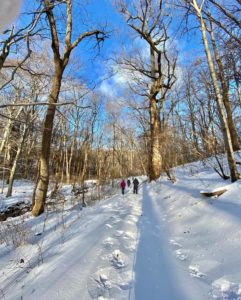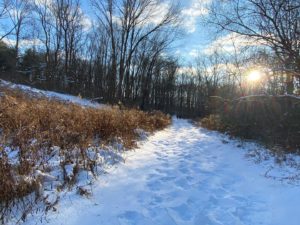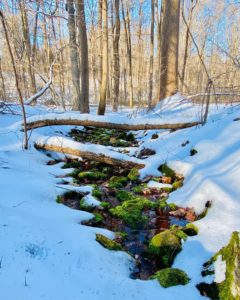One of the best things about being outside the fence in winter is the open view through the mature woodlands. Early in winter the leaves of beeches (Fagus grandifolia) and oaks (Quercus sp.) still cling to the trees, lending their gold and burnt orange colors to the otherwise grey of winter. The view becomes less obstructed as winter progresses and the leaves are torn from the trees by the weather.

The Rocky Run Trail (Blue blazes) is a great path to traverse in winter as it winds along both sides of its namesake for 1.9 miles on gentle slopes through varying forest types.
Beginning at Gate 1 (near the Pond), the trail passes through a mature forest. Look for a low, evergreen plant, spotted wintergreen (Chimaphila maculata), and beechdrops (Epifagus virginiana), resembling a twig stuck in the ground. Beechdrops have no chlorophyll and are parasitic on the roots of beech trees. Their presence tells us that the soil here contains much organic material and complex mycorrhizal relationships with the plants.
Farther down the trail (1/10 of a mile) the forest changes markedly. Note how the view through the understory is obstructed as vines cover many of the trees and non-native multiflora rose (Rosa multiflora) dominates the shrub layer. This forest has been taken over by many non-native invasive species like Oriental bittersweet (Celastrus orbiculatus), and Japanese honeysuckle (Lonicera japonica). This forest is not healthy and contains much less biological diversity, and is less resilient than the forest encountered at the start.

After passing a meadow on the right, the forest again closes in. The meadow was formerly part of what is called “Middle Farm.” This area was farmed in the mid 1800s and is now maintained as a meadow by mowing and burning.
Heading downstream along the trail, note how different species of trees begin to appear. This area is a mid-stage successional forest. Tulip tree (Liriodendron tulipfera) and many species of oak (Quercus sp.), including chestnut (Q. montana), white (Q. alba) and red (Q. rubrum), are giving way to a forest of beech and hickory (Carya sp.), including shellbark (C. laciniosa), mockernut (C. tomentosa) and pignut (C. ovata).
Sandy’s Bench provides a good vantage point of the valley of Rocky Run. Sandy’s Bench is a memorial with the inscription “Sandy’s Window Now and Forever” inscribed on the backrest. It is located on the purple blazed trail connecting the Blue Trail to the White Trail on the north side of Rocky Run. Look for foraging squirrels and perhaps deer or a coyote. Many species of birds can be seen here like pileated, downy and red-bellied woodpeckers, blue jay, junco, chickadee and other usual winter birds.

The Rocky Run Trail bears repeated visits during winter, as late winter brings a subtle green and red to the valley from the early growing skunk cabbage (Symplocarpus foetidus), spicebush (Lindera benzoin) and the emerging maple (Acer sp.) buds.
A little way downstream is Indian Rock, a story in itself. So much to see and hear. If you would like to come out for a guided hike through Tyler’s Natural Areas, check out our Calendar for one of our Winter Warm-up Hikes, or the monthly Trail Hikes with Chester County Trail Club. It’s a great way to explore this special part of the property.






